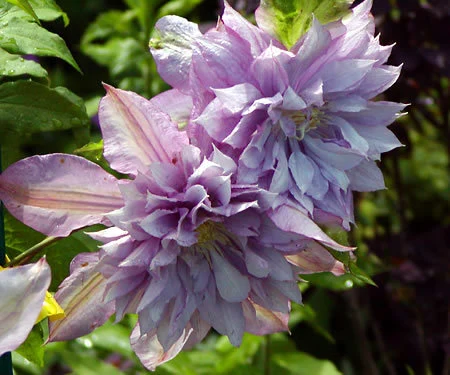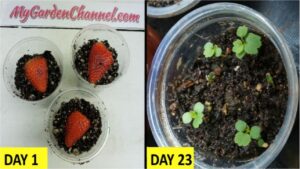Overview
- Botanical Name: Clematis ‘Proteus’
- Common Name: Proteus Clematis
- Plant Type: Deciduous, flowering vine
- Family: Ranunculaceae
- Hardiness Zones: USDA zones 4–9
- Height: 6 to 10 feet
- Spread: 3 to 4 feet
- Bloom Time: Late spring to early summer (double blooms), followed by smaller single blooms in late summer
- Flower Color: Mauve-pink to lavender with cream or yellow centers
- Growth Rate: Moderate
- Exposure: Full sun to part shade
- Soil Type: Well-draining, fertile, moist
- Vine Support: Trellises, arbors, fences, or obelisks
Description
Proteus Clematis is a hybrid clematis cultivar prized for its large, multi-layered, double blossoms that resemble roses or dahlias. The primary flush of double flowers appears in late spring or early summer, with a secondary bloom of single or semi-double flowers later in the season. The flowers have a romantic, old-world appearance, with shades of lavender, mauve, and soft pink that shift depending on light and weather conditions.
This cultivar is a member of Pruning Group 2, meaning it blooms on both old and new wood, which allows for a long flowering season when pruned correctly.
Ideal Growing Conditions
Sunlight
- Full sun to part shade
- Ideally, at least 6 hours of sunlight per day
- In hotter climates, provide afternoon shade to prevent fading or stress
- Clematis likes its head in the sun and roots in the shade—mulch or low groundcovers can help keep roots cool
Soil
- Fertile, well-draining soil
- pH between 6.0 and 7.0
- Enrich planting area with compost or aged manure before planting
Avoid heavy clay or poorly drained soils. Clematis roots hate standing water.
Planting Instructions
When to Plant
- Best planted in early spring or fall when soil is workable and temps are moderate.
How to Plant
- Dig a hole twice as wide and about a foot deep.
- Mix compost into the soil at the bottom.
- Place the plant so that the crown (where stems meet roots) is 2 to 3 inches below soil level—this encourages new shoots and protects from dieback.
- Backfill, firm the soil, and water thoroughly.
- Add mulch or ground cover to shade the root zone.
Provide a support structure like a trellis, arbor, fence, or obelisk nearby for the vine to climb.
Watering
- Clematis prefers evenly moist soil but not soggy
- Water deeply once or twice a week, depending on rainfall
- Avoid overhead watering when possible to minimize fungal issues
- Apply mulch (2–3 inches) to help retain soil moisture and regulate temperature
Fertilization
- Feed regularly during the growing season to encourage robust blooms and healthy foliage
Fertilizer Routine
- Spring (after buds appear): Use a balanced fertilizer (10-10-10 or 5-10-10)
- Midseason (after first flush of flowers): Use a bloom-booster fertilizer low in nitrogen
- Avoid heavy feeding late in the season to prevent tender new growth before frost
Pruning (Group 2 Clematis)
Proteus is in Pruning Group 2, which requires light pruning to encourage both early and late blooms.
Pruning Guide
- Late winter or early spring: Cut back weak or dead stems to a strong pair of buds.
- After first bloom (early summer): Lightly trim spent flowers and prune lightly to encourage reblooming.
- Don’t prune hard—most early blooms come from last year’s growth.
Pruning too aggressively may result in fewer or no early blooms.
Supporting and Training
Proteus Clematis is a twining vine and climbs by wrapping its leaf stems around nearby supports.
- Provide a structure with thin supports—like mesh, wires, string, or narrow trellis rungs.
- Gently guide and tie new growth with soft ties or twine if necessary.
Allow airflow around the plant to reduce mildew or fungal issues.
Pests and Problems
Clematis is generally low-maintenance, but can experience:
Common Issues
- Clematis wilt: A sudden collapse of vines due to fungal infection. Cut affected stems back to the base. Healthy roots usually resprout.
- Powdery mildew: White powder on leaves—reduce humidity, increase air circulation, and apply organic fungicides if necessary.
- Aphids: Treat with insecticidal soap or strong blasts of water.
- Slugs/snails: May chew on young shoots and leaves—use barriers or bait.
Good cultural practices and regular observation prevent most major issues.
Winter Care
- Hardy down to USDA zone 4 with proper mulching
- In colder regions, apply a thick mulch layer (4 inches) around the base in late fall
- Protect from wind exposure if possible
- Do not prune hard before winter; leave stems in place to shield lower buds
Container Growing
While Proteus is best in the ground due to its mature size, it can be grown in large containers (at least 18–24 inches deep and wide) with:
- Well-draining potting mix
- A sturdy trellis or obelisk
- Consistent watering and feeding
Keep roots cool and shaded—consider insulating the container in colder climates or moving it to shelter in winter.
Companion Plants
Clematis pairs beautifully with:
- Roses (especially climbing varieties)
- Hydrangeas
- Shrubs like boxwood or spirea
- Perennials such as salvia, daylilies, nepeta, or peonies
- Groundcovers to shade the root zone: heuchera, creeping thyme, sweet woodruff
Choose plants that complement Proteus’s romantic color palette and similar light/moisture needs.
Propagation
By Layering
- Bend a flexible stem to the ground in spring
- Make a small wound on the underside and pin it under the soil
- Roots form in several months; cut from parent and transplant
By Cuttings
- Take softwood cuttings in early summer or semi-hardwood cuttings in late summer
- Use rooting hormone and place in a moist, well-draining propagation medium
Summary
| Attribute | Detail |
|---|---|
| Light | Full sun to part shade |
| Soil | Moist, well-draining, fertile |
| Height | 6–10 feet |
| Spread | 3–4 feet |
| Bloom Time | Late spring to early summer (double), late summer (single) |
| Pruning Group | Group 2 |
| Water Needs | Regular; keep evenly moist |
| Special Features | Double blooms, reblooms, romantic color |
| Uses | Trellises, arbors, fences, containers |


